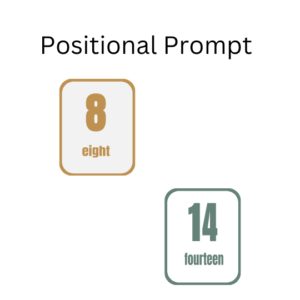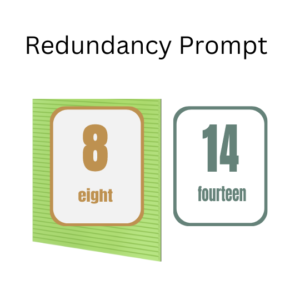2 Categories of Prompts
Response and Stimulus
A prompt MUST come between the SD and behavior. It has to work to be considered a prompt.
Response prompts: (Act on the learner)
Model- show them what to do. Example) SD: “Touch head” (Model touching your head) Learner touches their head.
Verbal- tell them what to do. Example) SD: “When teaching imitation, the BT touched her head” (Give direction touch your head) Learner touches their head.
*Physical prompts tend to be preferred over verbal prompts because verbal prompts are very difficult to fade. Verbal prompts can easily become the SD the for the learner.
Physical- physically help them do it. Example) SD: “Touch head” (Help them physically touch their head) Learner touches their head.
Stimulus prompts : (Act on the stimulus)
Positional- When you want the learner to discriminate among a set stimuli. For example, “Find number 8,” you just put the correct response closer to the child.

Fading for positional prompts- Little by little put them closer together.
Movement- Point to, tap or move the correct stimulus.
There is no specific way to fade this out.
Redundancy – Do something to make the stimulus more salient by pairing it with something indicating it is the right response. (In real life, I don’t ever use this. It tends to confuse learners because they relate the wrong SD and Response. They tend to think the SD is the visual prompt and not what you are saying.)


2 Mains Categories of how to prompt and fade prompts
*You always prompt after a correct response because that’s how they learn what the response is supposed to be. Most times, when you are prompting, it’s not to prompt compliance, it’s to teach the learner what you want them to do. You can differentiate with reinforcement and give an independent response more reinforcement.
Most to least (AKA Errorless learning)- The child NEVER gets a chance to be wrong. You provide a FULL prompt immediately and then fade.
Full physical prompt-
FPP: If touching their head you pick up their hands and put them on their head.
PPP: Then you pick their hand up, bring them halfway and have them finish.
PPP: Then you touch their elbow and have them finish.
Finally, they do it independently.
Full echoic- Say the whole word and then part of the word.
FEP “Bubbles”:
PEP “Buh”
Independent
Least to most
You either give them a chance to respond independently at first or start with the least intrusive prompt and then prompt as much as necessary.
There is also graduated guidance-
Different from most to least. There is no set order. You follow the person around and you prompt them physically as necessary. Try to fade the distance of your prompts. For example, touch their hand first and then their elbow. But, there is no set order of prompts. You are always just using whatever prompt you need.
Citation: Cooper, J. O., Heron, T. E., & Heward, W. L. (2019). Applied Behavior Analysis (3rd Edition). Hoboken, NJ: Pearson Education.



